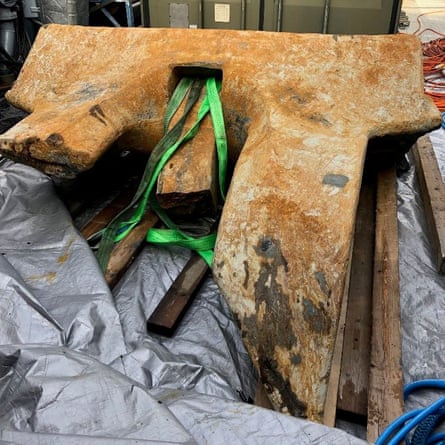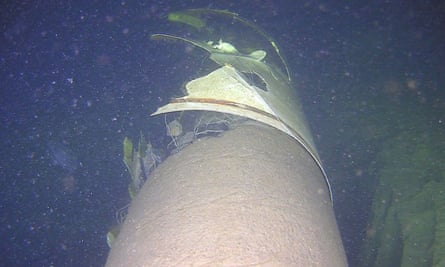Finnish investigators have recovered a large ship’s anchor from near the spot where a Baltic Sea gas pipeline was extensively damaged and are seeking to establish whether it came from a Chinese container vessel.
Finland’s central criminal police (KRP) said on Tuesday that the anchor, weighing 6 tonnes and missing one of its prongs, had been lifted from the seabed using a navy crane. Deep drag marks were found on both sides of the fractured pipeline.
The country’s National Bureau of Investigation (NBI), which last week said inquiries were focused on the Hong Kong-flagged, Chinese-owned NewNew Polar Bear, told reporters in Helsinki on Tuesday that the container ship was missing a front anchor.

Efforts had been made to contact the vessel, whose movements closely coincided with the pipeline damage, but had so far proved unsuccessful, the NBI said, adding that the investigation was now focused on whether the damage was deliberate.
The NBI chief, Robin Lardot, said: “The next questions are about whether it was intentional, negligence, poor seamanship, and that’s where we get into whether there could be a motive for what’s going on. It’s too early to answer that at this stage.”
Helsinki confirmed the damage to the Balticconnector gas pipeline and parallel Estlink data communications cable between Finland and Estonia on 11 October, two days after operators shut the pipeline down after a sudden drop in pressure.
Investigators subsequently said they suspected the damage was caused by “an external force” that was “mechanical, not an explosion”. The state security intelligence service said the involvement of a state actor “cannot be ruled out”.
Finland joined Nato earlier this year after abandoning its longstanding policy of non-alignment in the wake of Russia’s invasion of Ukraine, and the transatlantic alliance has pledged a “united and determined response” if the pipeline damage was caused by sabotage.
Balticconnector’s operators have said it will take at least five months to repair the pipeline and it is unlikely to come on stream again until April 2024 at the earliest. Finland relies on gas for about 5% of its energy supplies.
Separately on Tuesday, Sweden’s prime minister, Ulf Kristersson, said damage to a second telecommunications cable running under the Baltic Sea between Sweden and Estonia was “purposeful”, but declined to be drawn on details. “We will not be more precise than that as of today,” Kristersson told reporters.
The Swedish navy told public broadcaster SVT that tracks had been found on the seabed nearby, but added: “We don’t know if it’s deliberate or an accident.”

Nato’s secretary general, Jens Stoltenberg, said on Tuesday alliance members had “tens of thousands of kilometres” of submarine internet cables, power cables, gas pipelines and oil pipelines from the Baltic to the Mediterranean.
“Of course, these types of undersea critical infrastructure are vulnerable,” Stoltenberg said, adding that Nato – which stepped up patrols in the Baltic after the incidents – was working with the private sector, which “owns most of this critical infrastructure”.
The alliance launched a new centre for protecting undersea pipelines and cables in June after a still-unsolved series of explosions last year that ruptured three of the four Nord Stream pipelines that carried Russian gas to western Europe.











